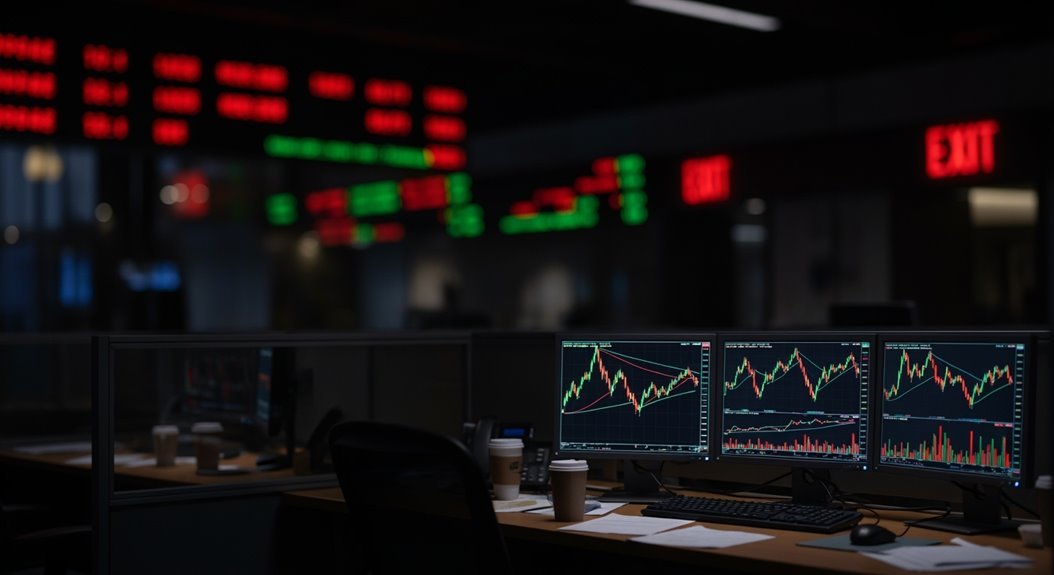Overnight trading lets investors buy and sell stocks outside regular market hours through electronic communication networks (ECNs). These systems operate from 4:00 AM to 8:00 PM Eastern Time, covering pre-market and after-hours sessions. Traders can react to breaking news, earnings reports, and global events when traditional exchanges are closed.
However, overnight trading comes with increased risks. Liquidity is limited. Price gaps can cause substantial losses. Bid-ask spreads widen considerably. Understanding these mechanics reveals essential considerations for extended-hours participation.
Understanding the Basics and Timing of Overnight Trading

Twenty-four hours a day, five days a week—that’s how traders can potentially access stock markets through overnight trading sessions. This extended window runs from 8:00 PM EST Sunday to 3:50 AM EST Friday, covering periods when traditional exchanges are closed.
Overnight trading splits into two main sessions: pre-market, starting before 9:30 AM ET, and after-hours, beginning after 4:00 PM ET. These sessions operate through electronic communication networks rather than centralized exchanges.
The timing serves multiple purposes. International investors can trade during their daytime hours. Busy professionals get market access outside work schedules. Most importantly, traders can react immediately to breaking news, earnings reports, or economic data released when regular markets are shuttered.
Trading volumes drop markedly during these periods. Fewer participants mean less liquidity and wider bid-ask spreads. Orders may be executed partially or not at all due to the reduced number of available counterparties. Limit orders are typically preferred during overnight sessions to help manage execution prices amid the increased volatility that characterizes these extended trading hours. Orders must be placed as Day Limit orders since all orders expire automatically at 3:50 AM EST if not executed. But the opportunity remains valuable for those seeking extended market exposure.
How Overnight Trading Works Through Electronic Networks
While traditional stock exchanges shut down each evening, electronic communication networks keep the market alive. ECNs are automated systems that match buy and sell orders electronically. No human intervention needed.
These networks operate independently from centralized exchanges like the NYSE or Nasdaq. They connect buyers and sellers directly. Think of them as digital matchmakers working around the clock.
ECNs enable trading from 4:00 a.m. to 8:00 p.m. ET for after-hours sessions. Pre-market runs until 9:30 a.m. when regular trading begins. The process is straightforward: investors place orders through their brokers, which route to ECNs for execution.
Speed matters here. Orders execute instantly when matches occur. But there’s a catch. Limited participants mean fewer trading opportunities. Lower liquidity creates wider bid-ask spreads. These conditions often lead to higher volatility compared to regular trading hours.
Most online brokers provide ECN access today. This democratizes overnight trading for retail investors. Previously, only institutions had this privilege. Now anyone can react to global news breaking after markets close. Extended trading allows investors to respond to major events that occur when exchanges are closed. Trading activity peaks at 9:00 PM when Asian markets open, creating the highest volume period for overnight sessions.
Benefits and Strategic Opportunities for Investors
Overnight trading opens doors that slam shut at 4 p.m. Global investors suddenly have access. Workers with day jobs can finally participate. The world doesn’t stop spinning when the NYSE closes.
Price movements happen constantly. Earnings reports drop after hours. Geopolitical events unfold overnight. Smart traders position themselves before regular sessions begin. They capture these fluctuations while others sleep.
Risk management becomes round-the-clock. Futures and options provide hedging tools against international shocks. Portfolio adjustments happen in real-time. No more waiting helplessly for morning gaps.
Diversification expands globally. Multiple time zones mean multiple opportunities. Asset classes trade continuously across different markets. Geographic dependence shrinks. However, traders must navigate wider bid-ask spreads that result from reduced liquidity during overnight hours.
Capital efficiency improves dramatically. Instead of 6.5 hours daily, investors get 24/5 access. Money works harder. Idle time disappears. Market inefficiencies get exploited immediately. US Treasuries and global corporate bonds extend trading opportunities for 22 hours daily. Major exchanges are preparing for this transformation with stress-testing to ensure their systems can handle the increased capacity.
The competitive advantage is clear. Proactive management beats reactive scrambling. Information flows constantly. Those who adapt profit first.
Risks and Regulatory Considerations to Know

Extended-hours trading frequently comes with a harsh reality check. Overnight positions face substantial risks that catch many traders off-guard.
Price gaps represent the biggest threat. Stocks jump dramatically at market open due to after-hours news. These moves are fundamentally coin flips—up or down with equal probability. Gap risk affects every overnight position, regardless of strategy.
Liquidity evaporates during extended hours. Fewer traders mean partial fills, failed executions, and wider spreads. Orders that would execute instantly during regular hours may sit unfilled overnight.
| Risk Factor | Regular Hours | Overnight Hours |
|---|---|---|
| Liquidity | High volume | Thin trading |
| Spreads | Tight | Wide |
| Volatility | Moderate | Extreme |
| Execution | Reliable | Uncertain |
| Costs | Standard fees | Higher commissions |
Regulatory protections also diminish. Extended-hour sessions operate under different rules with limited order types. Brokers impose stricter requirements and higher fees. Many platforms lack real-time data access during overnight periods. Traders may face margin calls if overnight losses exceed account equity requirements.
Stop-loss orders become unreliable when prices gap violently.
Frequently Asked Questions
Which Specific Stocks and ETFS Are Available for Overnight Trading?
Over 10,000 U.S. stocks trade overnight through platforms like CommSec and Interactive Brokers. Major NYSE and Nasdaq listings are accessible, including tech giants Apple, Microsoft, and Amazon. Popular ETFs like SPY, QQQ, and DIA offer overnight access. Most large-cap stocks with high liquidity qualify. Sector ETFs, bond funds, and commodity ETFs also trade overnight. Access varies by broker and requires proper trading permissions for the 8:00 PM to 3:50 AM ET window.
How Do Overnight Trading Fees Compare to Regular Market Hour Commissions?
Overnight trading commissions often mirror regular market hours at most brokers. The real difference lies in spreads. Lower liquidity creates wider bid-ask spreads, making trades effectively more expensive. Some brokers charge additional premiums for after-hours sessions. Interactive Brokers maintains standard commission structures overnight. However, reduced market maker participation drives up implicit costs through unfavorable fills and increased slippage, even when nominal fees stay unchanged.
Can I Use Margin Accounts for Overnight Stock Purchases?
Margin accounts can be used for overnight stock purchases, but with restrictions. Most brokers allow it during extended hours trading. However, some platforms limit margin buying power to regular market hours only. Federal regulations still apply – 50% initial margin and 25% maintenance requirements. Brokers often impose stricter overnight margin rules due to higher volatility and reduced liquidity. Interest accrues daily on borrowed funds until positions close.
Do Stop-Loss Orders Work During Overnight Trading Sessions?
Stop-loss orders face significant limitations during overnight sessions. Price gaps occur 78% of trading days, causing orders to execute at unexpected levels or miss trigger prices entirely. Overnight jumps can push prices well beyond stop-loss thresholds, creating larger losses than intended. Flash crashes during after-hours trading further erode effectiveness. While stop-loss rules can improve performance in some market conditions, they provide imperfect protection against overnight volatility.
What Happens if My Overnight Trade Doesn’t Execute Completely?
When overnight trades don’t execute completely, brokers typically keep unfilled portions active as open orders. Traders receive notifications about partial fills via alerts or emails. The unexecuted shares remain pending until the next trading session. This creates portfolio allocation mismatches and exposes positions to overnight volatility. Traders can modify order parameters or cancel remaining portions when markets reopen. Some brokers automatically cancel unfilled after-hours orders unless specified otherwise.



